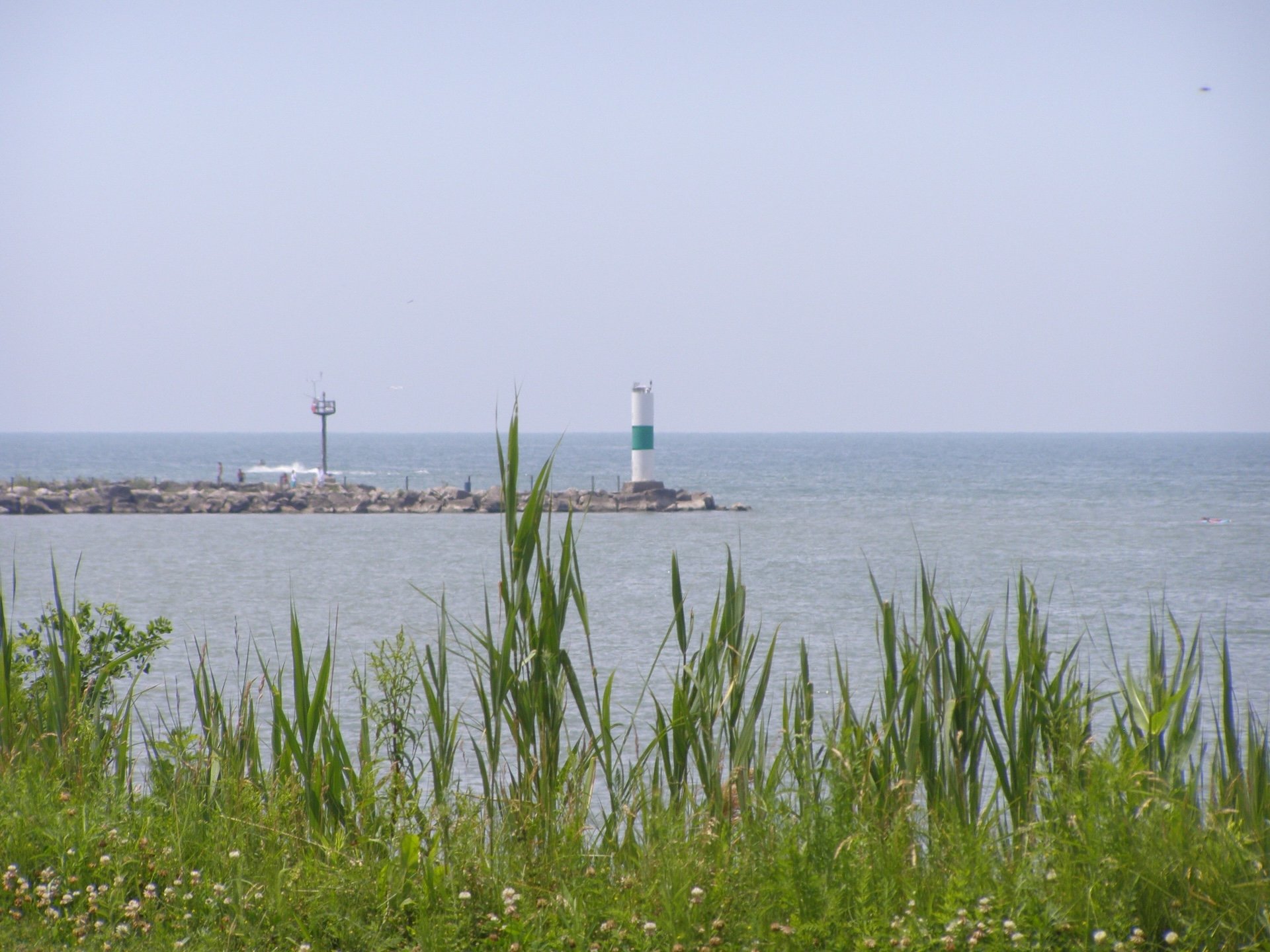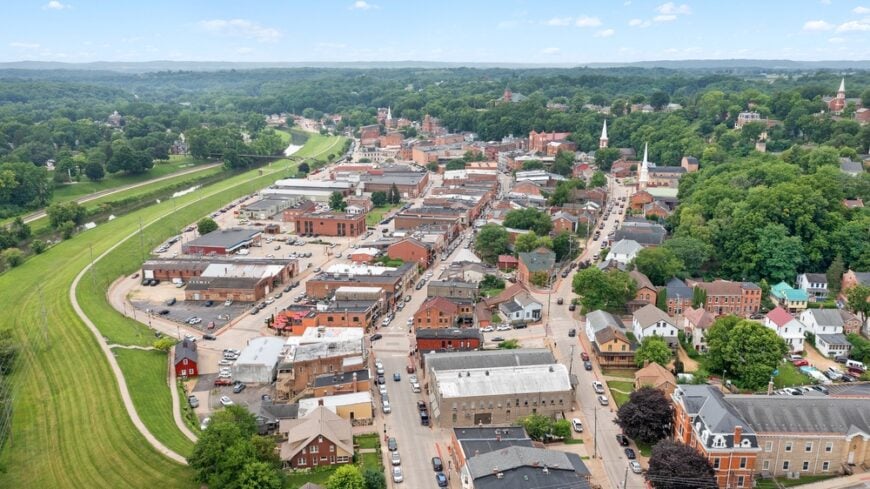
Large Midwestern cities often grab the headlines, yet many of the region’s most remarkable historic homes stand quietly in smaller communities. These towns invite visitors to linger on shaded porches, admire period-perfect woodwork, and trace the stories of settlers, and dreamers who shaped the nation’s heartland.
Our list moves in reverse order, counting down from number 15 to number 1, so each stop builds anticipation for the next. Along the way, we point out lesser-known museums, walking tours, and scenic byways that deepen the experience.
Every destination offers a window into the past, from communal German villages to bluff-top Victorian neighborhoods. Pack comfortable shoes and a healthy curiosity—there are porch swings to try and centuries-old floorboards waiting to creak beneath your feet.
15. Amana Colonies, Iowa: Communal Heritage and Preserved Homes
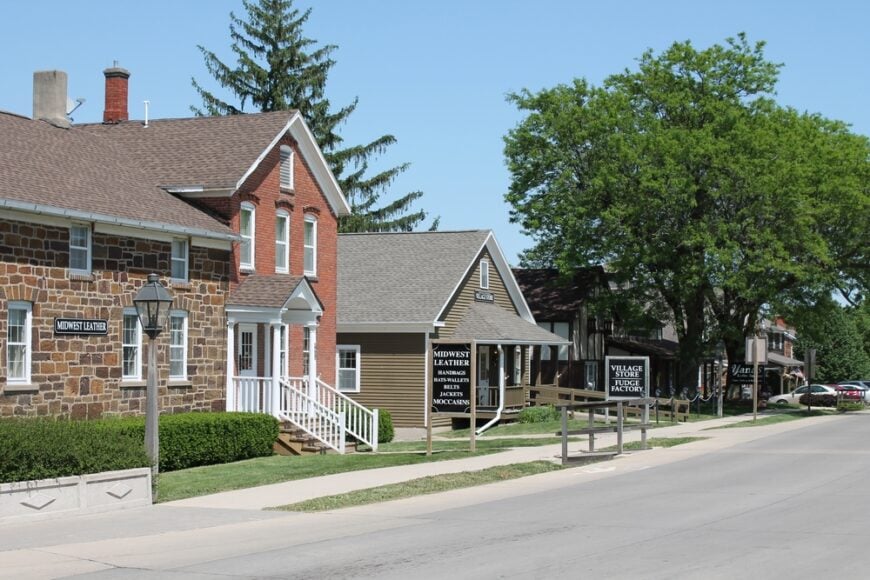
The seven Amana villages feel like one living museum, where simple brick and sandstone homes reveal a community that once shared nearly everything, right down to daily meals.
We appreciate how many residences still display original wood-fired stoves and hand-hewn furniture, details showcased during the Heritage Museum tour and the occasional open-house weekend.
After exploring the Homestead Church or the Cooper Shop, visitors can sample traditional pickles and sausages made with recipes that date back to the 1850s. Craft shops such as the Broom and Basket in West Amana give an authentic look at everyday life in a communal society.
Cyclists often ride the quiet roads between villages, stopping at photogenic barns and lily-lined ponds. Evenings end nicely with a stein of Märzen at Millstream Brewing, Iowa’s oldest microbrewery, housed in a former woolen mill.
Amana Colonies offers 3-4 bedroom homes priced between $250,000 and $550,000, providing a chance to explore a rich history and beautifully preserved historical homes.
Where is Amana Colonies?
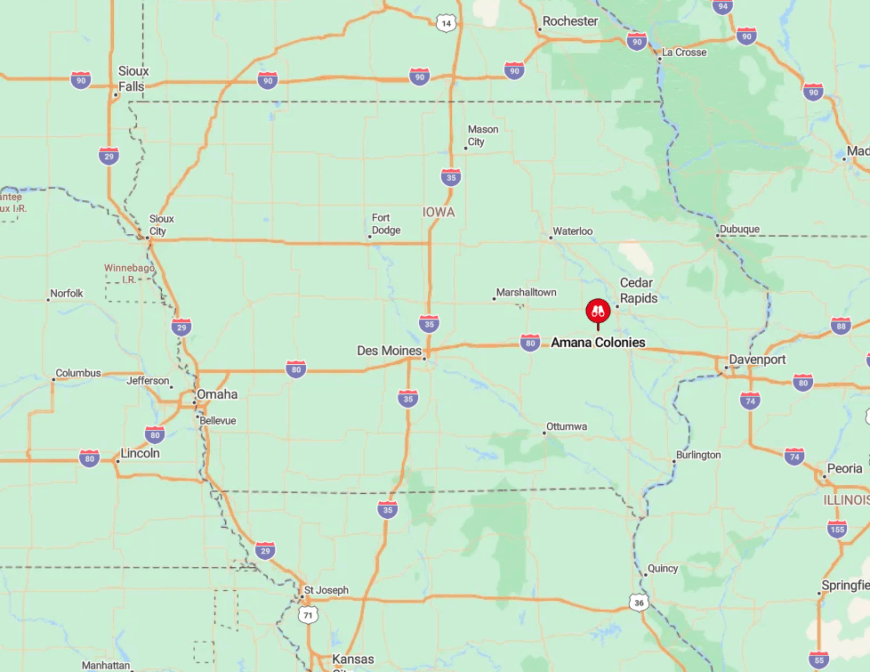
The colonies sit in east-central Iowa, about 25 minutes west of Iowa City and just off Interstate 80. Rolling farmland surrounds the villages, making the area feel secluded despite its proximity to major routes.
Most travelers drive, but the Eastern Iowa Airport in Cedar Rapids lies only 30 miles away for those who prefer to fly and rent a car. Scenic Highway 151 provides the most relaxed approach, offering sweeping views of cornfields broken by the distinctive Amana silos.
14. Arrow Rock, Missouri: A National Historic Landmark Village
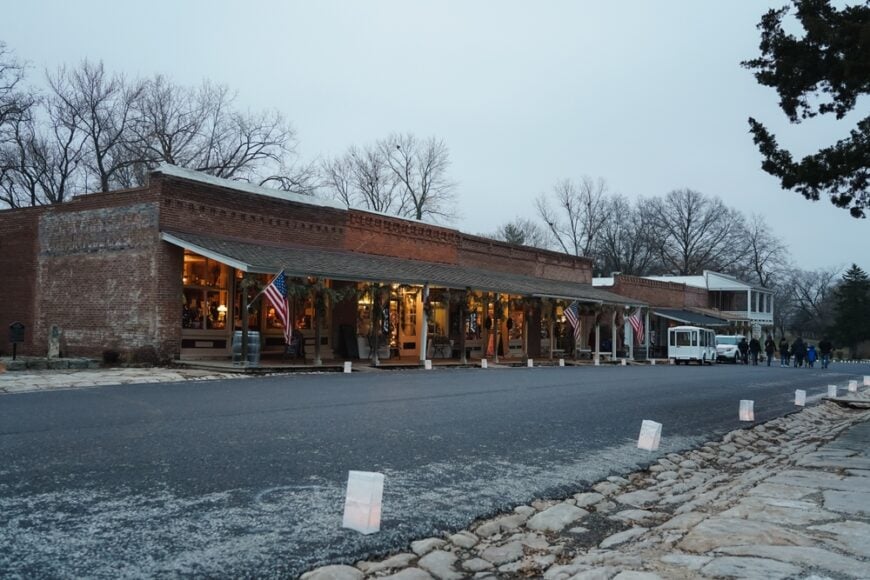
Arrow Rock looks much as it did when wagon ruts out front led to Santa Fe, with Federal-style brick homes and whitewashed clapboard cottages encircling a leafy boardwalk. Visitors can tour the 1829 J.
Huston Tavern, where meals are still served in rooms lit by tall windows and oil lamps, then wander up Main Street to the tiny post office that once handled frontier mail. Our favorite stop is the Black History Museum inside the former Brown’s Chapel, telling stories of free and enslaved residents rarely covered in textbooks.
Period interpreters often demonstrate spinning or coopering outside the Bingham House, the painter George Caleb Bingham’s onetime studio. Theater lovers should check schedules for the Arrow Rock Lyceum, a professional company performing in a converted 19th-century church.
Autumn brings fewer crowds and vivid foliage along the Missouri River bluffs, perfect for photographers. Arrow Rock presents 3-4 bedroom homes in the $200,000 to $500,000 range, a quaint village with a collection of historical homes that transport you back in time.
Where is Arrow Rock?

The village rests above a bend in the Missouri River, roughly halfway between Kansas City and St. Louis along Highway 70, then nine quiet miles north on Highway 41. Its bluff-top perch helped early traders spot approaching riverboats and still grants sweeping valley views today.
Columbia Regional Airport, an hour’s drive away, offers the closest commercial flights. Drivers enjoy detouring along the Katy Trail State Park, which skirts the river and passes little-known stone culverts and rail depots.
13. Lebanon, Ohio: Historic Homes and the Oldest Inn in Ohio
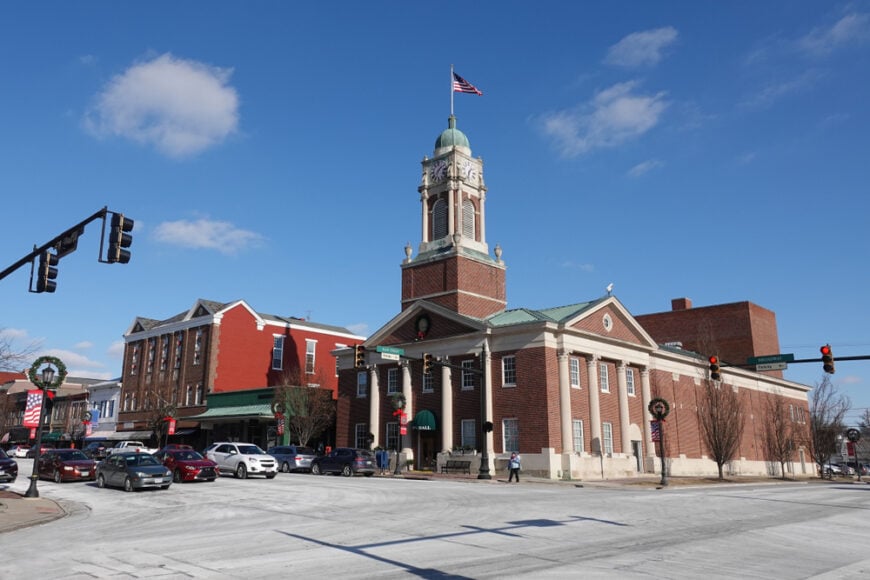
Lebanon’s brick sidewalks guide visitors past Federal, Greek Revival, and Queen Anne homes, many lovingly restored with period-appropriate paint and wrought-iron hardware.
Established in 1803, the Golden Lamb anchors downtown and has welcomed 12 presidents; guests can tour rooms named for each notable visitor even without booking a stay. A block away, Glendower Mansion offers costumed tours that reveal mid-19th-century life from cellar kitchen to rooftop widow’s walk.
The Warren County History Center displays Shaker furniture and a rare 1790 land deed signed with an “X” by a Revolutionary War veteran. Antique hunters browse Mulberry Street’s storefronts, while rail buffs ride the Lebanon Mason Monroe Railroad’s vintage coaches through farm country.
Live music fills the town square on summer Fridays, accompanied by the scent of fresh kettle corn. Lebanon features 3-4 bedroom homes priced between $300,000 and $600,000, a historic town offering charming homes and a glimpse into America’s past.
Where is Lebanon?

Between Cincinnati and Dayton, Lebanon lies just east of Interstate 71, making it an easy detour for anyone traveling that corridor. Rolling hills once favored for horse farms surround the town, and Caesar Creek Lake offers nearby boating and hiking.
Cincinnati/Northern Kentucky International Airport sits 40 miles south, while Dayton International is slightly farther north, giving visitors two convenient gateways. Those wanting a slower pace can follow U.S. Route 42, a scenic two-lane road that enters town beneath mature maples.
12. Lanesboro, Minnesota: Victorian Homes in the Bluff Country
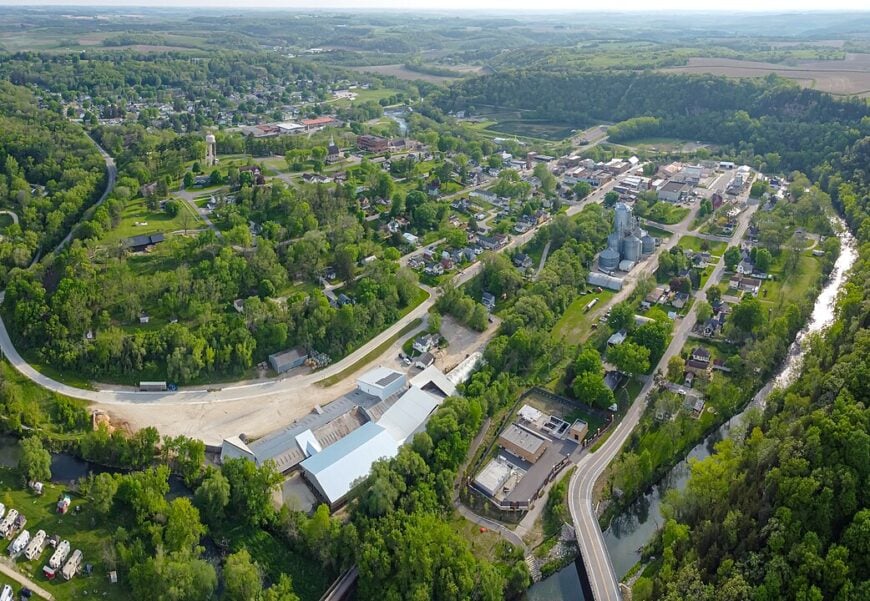
Nestled in a limestone valley, Lanesboro pairs gingerbread-trimmed B&Bs with dramatic bluffs that rise like a natural amphitheater. Many homeowners open parlors during the spring Heritage Home Tour, sharing stories of mill owners and river captains who built along the Root River.
Cyclists glide past these porches on the 42-mile Root River State Trail, pausing at picnic tables under century-old maples. The Commonweal Theatre, housed in a renovated cheese factory, stages classic and contemporary plays that draw talent across the region.
Our preferred hidden corner is Sylvan Park, where a short footpath leads to a secluded gazebo overlooking trout-filled streams. Lanesboro offers 3-4 bedroom homes in the $200,000 to $500,000 range, a town steeped in history with delightful homes that reflect its rich heritage.
Where is Lanesboro?

The town sits in southeastern Minnesota’s bluff country, about 50 miles southeast of Rochester and 15 miles north of the Iowa border. State Highways 16 and 250 converge here, winding through valleys dotted with dairy barns and Amish farmsteads.
Rochester International Airport provides the closest commercial service, with rental cars making the final scenic hour. Many visitors arrive by bicycle via the interconnected trail network, which links neighboring hamlets and waterfalls.
11. Cedarburg, Wisconsin: A Quaint Town with Stone Buildings
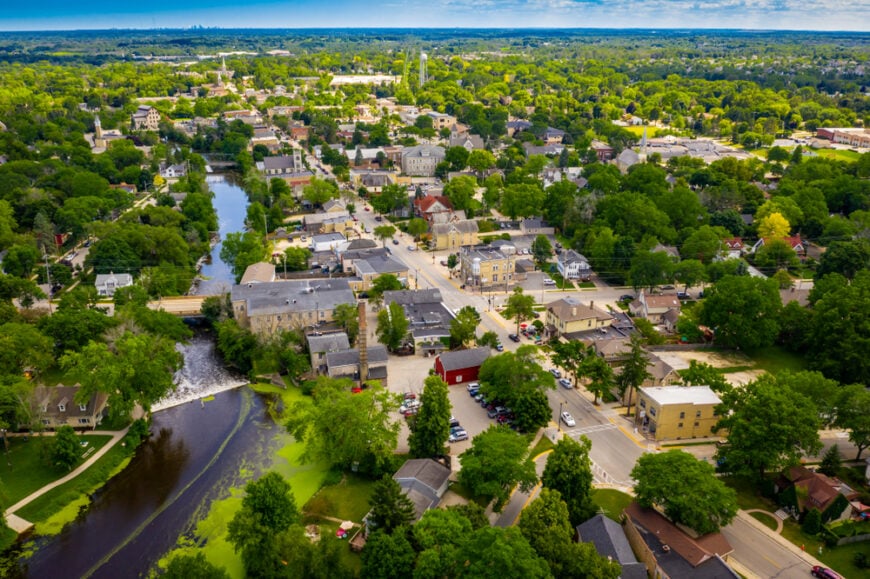
Cedarburg’s main street resembles a 19th-century photograph brought to life, lined with limestone mills, cast-iron storefronts, and gracious homes trimmed in spindlework. Inside the Hilgen-Schroeder Mill, artisans now sell pottery and hand-blown glass, while the upper floors display original timber beams.
Walking tours pass the 1876 Workers’ Cottages, proof that not only the wealthy left architectural legacies. Just outside town, Covered Bridge Park showcases Wisconsin’s last wooden-covered bridge, perfect for sunset photos amid fireflies.
Seasonal festivals—including Strawberry Fest and Winter Ice Carving—pair local produce with live folk music on shaded lawns. Cedarburg presents 3-4 bedroom homes priced between $300,000 and $600,000, a historic town filled with preserved homes and unique architecture to explore.
Where is Cedarburg?
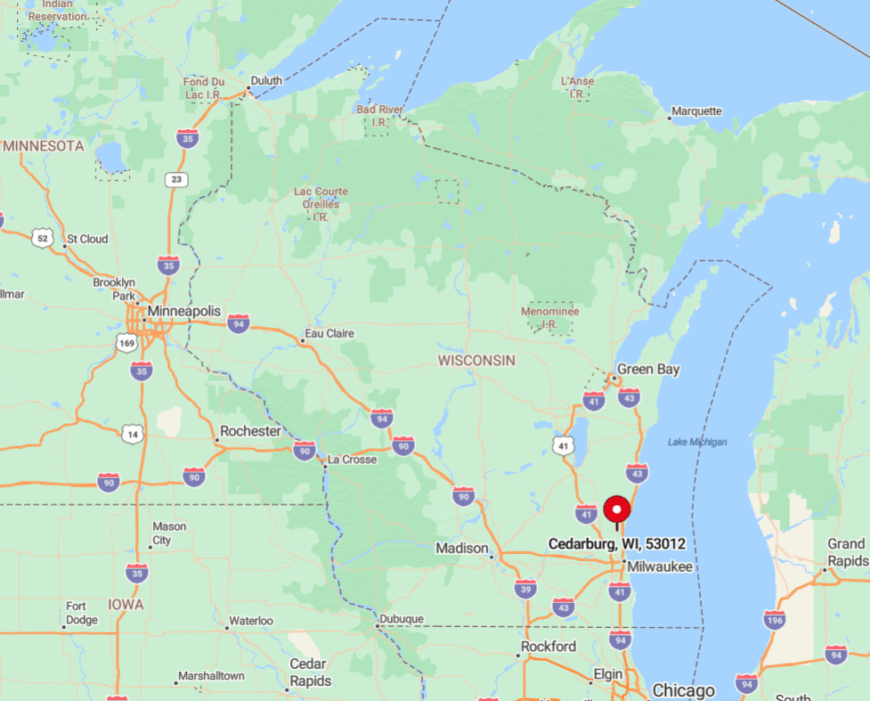
Located 20 miles north of Milwaukee, Cedarburg lies along Cedar Creek and is easily reached via Interstate 43, then a short hop west on Highway 60. The creek’s steady flow once powered the mills that built the town’s fortunes and still provides postcard reflections of stone arches.
General Mitchell International Airport in Milwaukee places visitors within a 30-minute drive. Weekend travelers often combine Cedarburg with the scenic Kettle Moraine drives, where glacial eskers and kettles create uncommon rolling terrain in the region.
10. New Harmony, Indiana: A Utopian Experiment Preserved

New Harmony feels intellectually charged two centuries after its twin utopian experiments, with Harmonist brick dwellings standing beside Owenite communal halls.
The Atheneum Visitor Center sets the stage, guiding guests to buildings like Thrall’s Opera House and the double-arch Bridge of Dreams. Guided Roofless Church walks at dusk highlight geometric shadows that architect Philip Johnson intended as a “cathedral without walls.”
We recommend the Scholle House garden, where heritage roses outline symmetrical beds reflecting the town’s orderly worldview. Artists in residence at the Granary often invite passersby to peek inside their studios, adding a contemporary layer to the historic fabric.
Evening strolls along the Wabash River interpretive trail offer quiet reflection amid cottonwoods and soft river breezes. New Harmony features 3-4 bedroom homes priced between $300,000 and $600,000, a fascinating historical town perfect for those who enjoy old homes and rich stories.
Where is New Harmony?
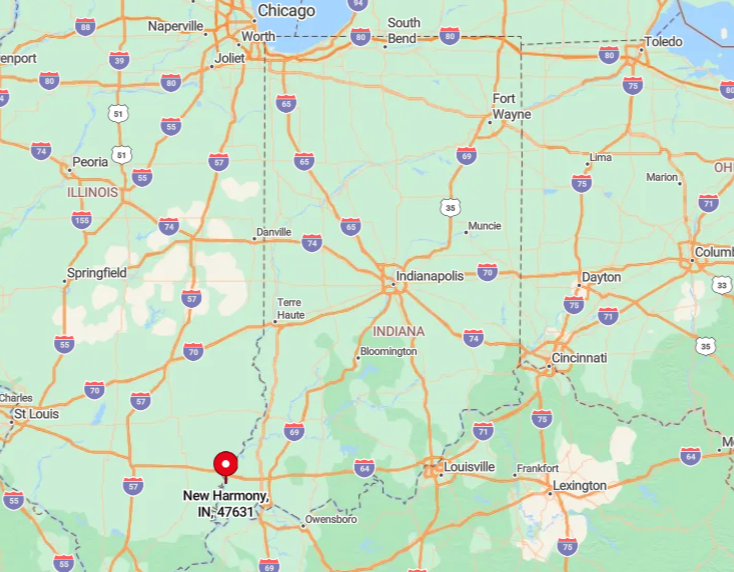
The town occupies Indiana’s southwest corner, a 30-minute drive northwest of Evansville via Highway 69. Flat floodplain fields give way to a grid of tree-lined streets laid out by the Harmonists in 1814.
Travelers from Illinois often reach New Harmony by crossing the gracefully arched Wabash Memorial Bridge, which frames the town against golden river sunsets.
9. Abilene, Kansas: Eisenhower’s Hometown with Pioneer Heritage

Abilene’s wide avenues showcase everything from modest prairie cottages to the stately Seelye Mansion, an 11,000-square-foot Georgian-Revival residence noted for its original Edison light fixtures.
The Eisenhower Presidential Library and Boyhood Home complex anchors the east side of town, drawing history buffs eager to study letters, uniforms, and a serene meditation garden.
Historic reenactors greet passengers boarding the Abilene & Smoky Valley Railroad’s 1919 steam locomotive for short excursions through tall-grass prairie. Our group loves stopping at the Dickinson County Heritage Center, where a 1901 carousel still spins to band-organ melodies.
After sunset, a self-guided tour of Victorian homes lit by porch lamps gives an atmospheric glimpse of early-1900s life. Abilene offers 3-4 bedroom homes in the $150,000 to $450,000 range, a smaller town with affordable options for exploring its historical homes.
Where is Abilene?
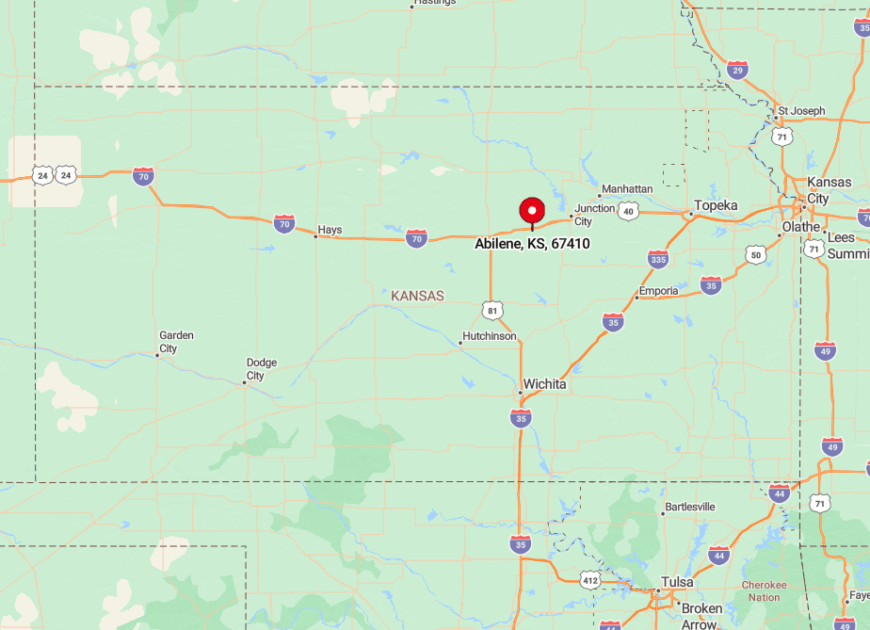
Abilene sits along Interstate 70 in central Kansas, 150 miles west of Kansas City and 100 miles north of Wichita. The Smoky Hill River meanders nearby, influencing the railroad routes that put Abilene on the map.
About 40 minutes east, Manhattan Regional Airport offers daily flights to Dallas and Chicago. Drivers can also reach town via the quieter U.S. Highway 40, which parallels I-70 and passes wheat fields dotted with stone fence posts.
8. Stillwater, Minnesota: Birthplace of Minnesota with Historic Charm

Perched on the bluffs above the St. Croix River, Stillwater boasts an impressive collection of lumber-baron mansions that sparkle under pressed-tin roofs and stained-glass transoms. Guided trolley tours climb these hills, sharing tales of fortunes made from white-pine logs floated downriver.
Lowell Park’s riverside paths reveal restored warehouses now housing bookshops and cafés, while the Warden’s House Museum interprets territorial history in an 1853 limestone structure.
A hidden stairway off Chestnut Street rewards climbers with sweeping river vistas and a look at tucked-away carriage houses. We often suggest timing a visit with the Stillwater Lift Bridge’s hourly openings, when pedestrians pause to watch boats slip underneath.
Evening paddlewheel cruises set out from the docks, their calliopes echoing against brick façades. Stillwater presents 3-4 bedroom homes priced between $250,000 and $550,000, a town brimming with beautifully restored historical homes and scenic river views.
Where is Stillwater?
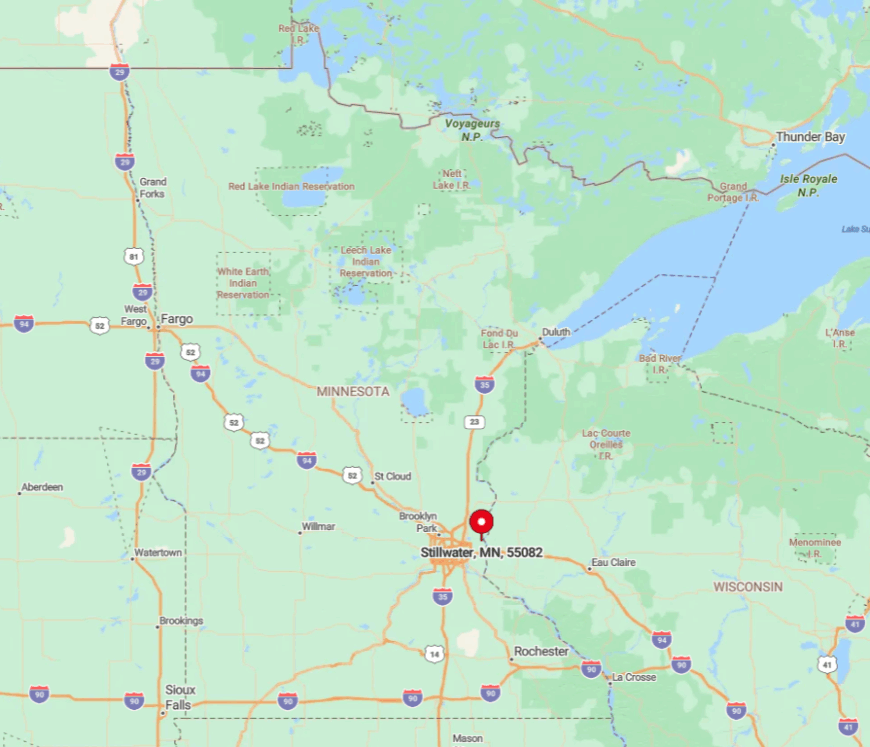
The city lies 25 miles east of Minneapolis-St. Paul, accessible by State Highway 36 and scenic County Road 12 along the river bluffs. It straddles the Minnesota-Wisconsin border, making it a popular gateway for drives through the St. Croix River National Scenic Byway.
Minneapolis–St. Paul International Airport is the main aviation hub, with rental cars reaching Stillwater in under 45 minutes. Many day-trippers arrive by bicycle via the Brown’s Creek State Trail, which conveniently deposits riders near Main Street’s antique shops.
7. Mineral Point, Wisconsin: A Historic Mining Town Frozen in Time
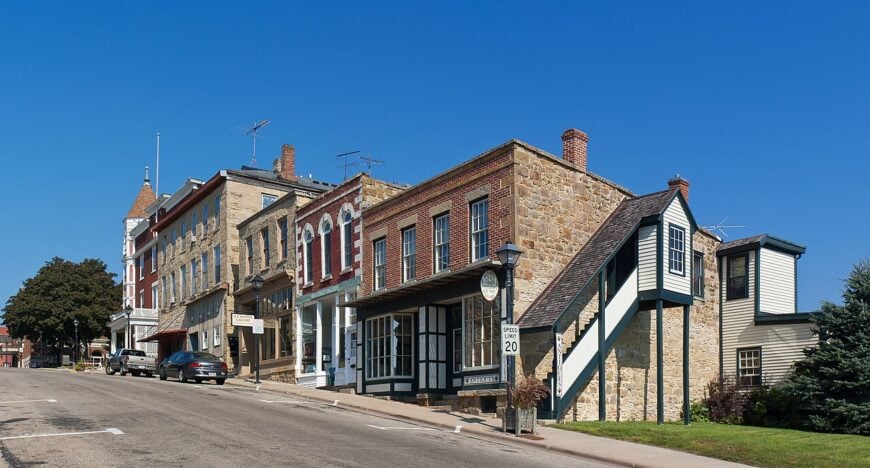
Founded by lead miners from Cornwall and Wales, Mineral Point preserves rows of stone cottages known locally as “penty,” some of which are today cozy lodging. The Pendarvis Historic Site offers costumed tours that include Cornish pasties baked in wood-fired ovens, a savory tradition miners carried across the Atlantic.
Artists now inhabit former mercantile buildings along High Street, producing pewter jewelry and raku pottery that recall the town’s hand-craft roots. Shake Rag Alley Center for the Arts hosts blacksmithing and printmaking workshops in restored cabins, embracing creative energy present since territorial days.
We suggest a sunset walk up Merry Christmas Mine Hill, where prairie grasses wave beside former mine shafts. Mineral Point features 3-4 bedroom homes in the $200,000 to $500,000 range, a town with a collection of historic homes and a rich artistic heritage.
Where is Mineral Point?

Mineral Point rests in Wisconsin’s Driftless Area, 50 miles southwest of Madison along U.S. Highway 151. Unlike the flat dairy country farther north, the unglaciated landscape gives the town rolling hills and hidden valleys.
Dane County Regional Airport in Madison provides the nearest commercial flights, with a scenic hour’s drive through farmland and forest. For an even more pastoral approach, travelers can follow County Road A, which parallels old stagecoach routes and passes barn quilts painted on weathered boards.
6. Pella, Iowa: Dutch Treasures in America’s Heartland

Pella greets visitors with red-brick streets, canal bridges, and the 1850s Vermeer Windmill—the tallest working windmill in North America. Many historic homes radiate from Central Park, including the Scholte House, where the town’s founder once hosted Abraham Lincoln for coffee.
Pella Historical Village features 21 buildings, including Wyatt Earp’s boyhood cabin, each with Delft tiles and carved oak cupboards. During April’s Tulip Time festival, costumed townspeople scrub streets in wooden shoes before parading past gabled roofs.
Hidden in plain sight, Klokkenspel plays Dutch melodies on bronze bells from a tower overlooking Franklin Street six times daily. Bakeries lure passersby inside with almond-filled letters and flaky Dutch pastries known as “poffertjes.”
Pella offers 3-4 bedroom homes priced between $300,000 and $600,000, a charming Dutch heritage town with colorful historical homes to visit and enjoy.
Where is Pella?
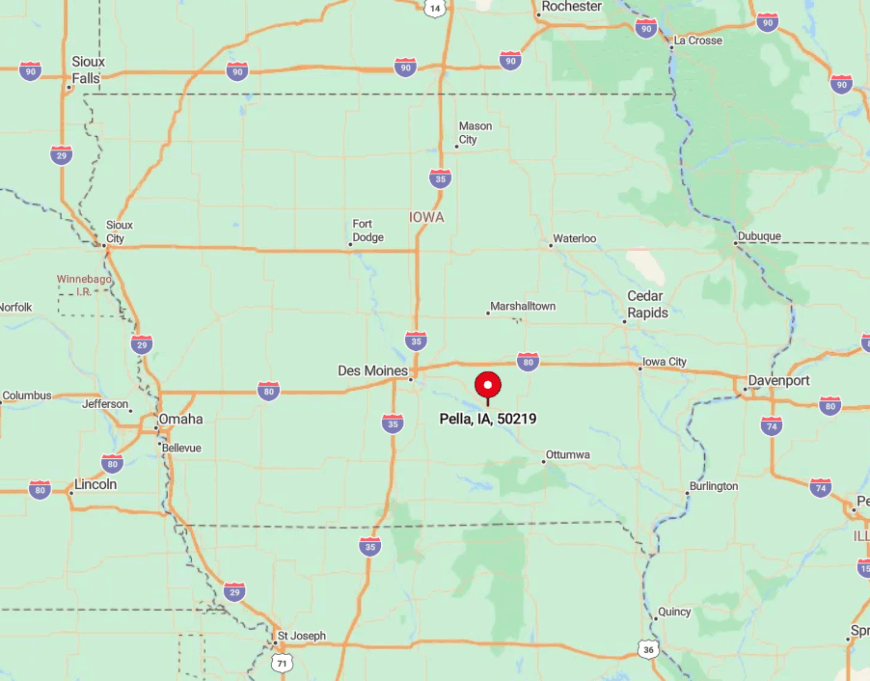
This Dutch enclave is 40 miles southeast of Des Moines, reachable via Iowa Highway 163, a four-lane route following gentle ridgelines. The town fringes Lake Red Rock, Iowa’s largest reservoir, providing boating and bald-eagle viewing minutes from downtown.
Des Moines International Airport is the primary gateway, with rental cars covering the remaining easy miles. Cyclists frequently arrive by way of the paved Volksweg Trail, which threads prairie and oak savanna before emerging beside the windmill’s sails.
5. Decorah, Iowa: A Blend of Norwegian Culture and Historic Homes

Decorah’s steep hills cradle clapboard homes adorned with rose-painted rosemaling, nodding to the Norwegian settlers who arrived in the 1850s. Vesterheim Museum occupies a downtown block, housing 12 historic buildings and the country’s most extensive collection of Norwegian-American artifacts.
Visitors can tour the Porter House, an 1867 Italianate residence with a preserved conservatory sheltering century-old orchids. Our group often picnics beneath the limestone bluff at Dunning’s Spring after a short hike to its 200-foot cascade.
The Trout Run Trail loops past Victorian neighborhoods and offers viewing platforms for the famous Decorah eagle nest. Boutiques along Water Street sell hand-knit mittens patterned after 19th-century Norwegian designs, an ideal souvenir.
Decorah presents 3-4 bedroom homes in the $250,000 to $550,000 range, a picturesque town filled with historical architecture and outdoor beauty.
Where is Decorah?
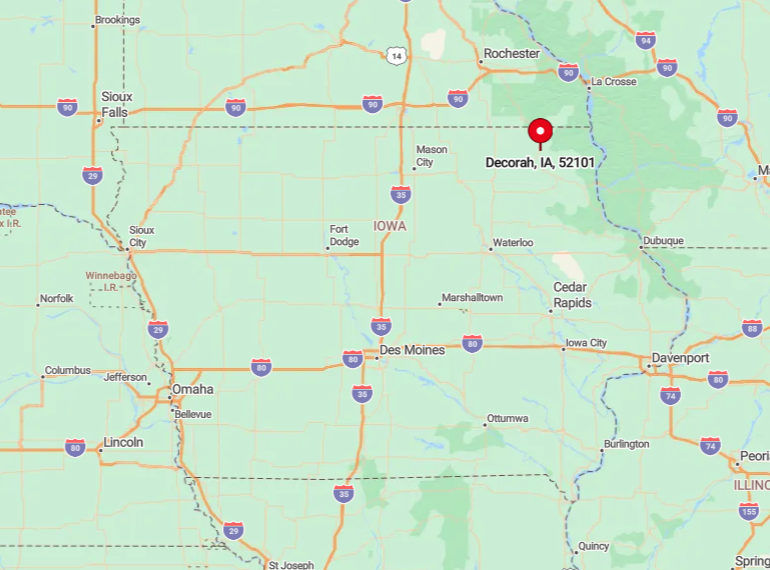
Decorah lies in Iowa’s northeast corner, 15 miles south of the Minnesota border and a scenic hour west of the Mississippi River on Highway 9. The surrounding Driftless landscape escaped glaciation, creating craggy cliffs and cold-water trout streams that are rare in the state.
Rochester International Airport is 70 miles north, while travelers from Chicago often follow U.S. Highway 20 through rolling farmland before angling north. A rental car remains the best option, though regional bus lines stop at Luther College for students and visitors alike.
4. Hermann, Missouri: German Heritage and Historic Vineyards
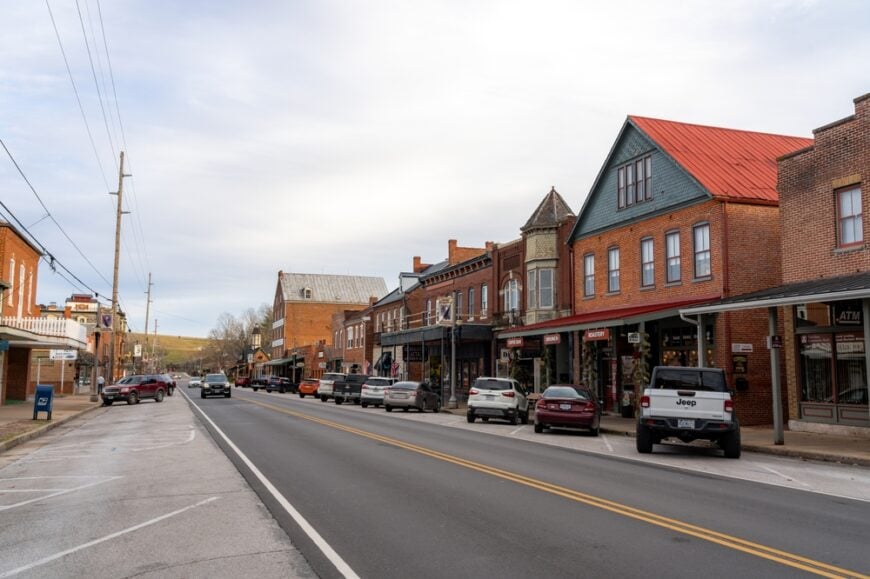
Hermann’s stone cellars and brick cottages climb the Missouri River hillside, echoing the Rhine Valley towns settlers left behind in the 1830s. Many grand homes double as bed-and-breakfasts, such as the 1883 Captain Wohlt House with ironwork balconies overlooking terraced gardens.
Deutschheim State Historic Site preserves two original 1840s residences furnished with Biedermeier chairs and red-striped feather beds. Wine aficionados revel in cellar tours at Stone Hill Winery, where candlelit tunnels once held Civil War soldiers captive.
Octoberfest weekends pair polka bands with saurkraut-laden plates, while quieter winter months offer unobstructed walks along the cobblestoned Wharf Street. Hermann offers 3-4 bedroom homes priced between $300,000 and $600,000, a small town that boasts beautiful homes and a rich history of German settlement.
Where is Hermann?
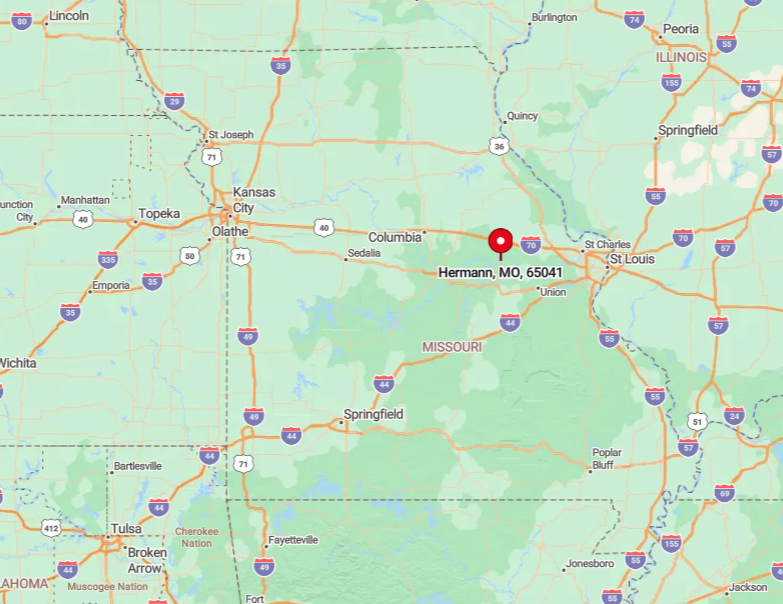
Positioned midway between St. Louis and Jefferson City, Hermann rests on Missouri Highway 100. He can also be reached by Amtrak’s Missouri River Runner, whose depot stands two blocks from the main square. The town sits within the Missouri River Valley, where loess bluffs create a microclimate ideal for Norton grapes.
Travelers flying into St. Louis Lambert International can rent a car for the scenic 75-minute drive through rolling vineyards. Many locals recommend the winding Route 94, nicknamed the “Missouri Weinstrasse,” for its postcard farmsteads and valley vistas.
3. Mackinac Island, Michigan: Victorian Splendor Without Cars
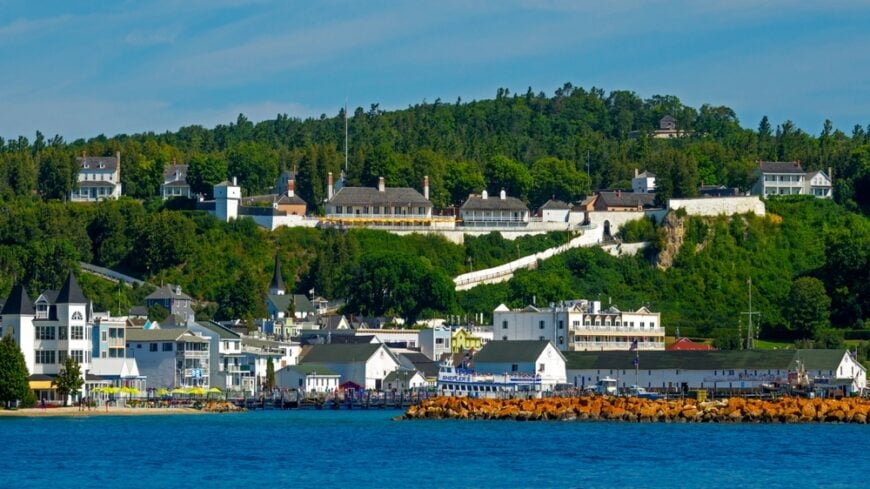
Horse hooves clip-clop past pastel cottages while Lake Huron breezes rustle lace curtains—a daily rhythm unchanged since motorcars were banned in 1898. Grand Hotel’s 660-foot porch draws admiration, yet quieter Barclay Cottage and Anne’s Tablet offer equally striking views without the crowds.
Fort Mackinac interpreters fire rifles from limestone ramparts, echoing the era when soldiers gazed upon these same gingerbread roofs. Cycling the island’s eight-mile perimeter road reveals hidden gems like British Landing’s quiet picnic spots and Arch Rock’s soaring limestone span.
Gardens burst with lilacs each June, celebrated by a parade of horse-drawn floats scented like old-fashioned perfume. Mackinac Island features 3-4 bedroom homes in the $400,000 to $700,000 range, a historic island with charming houses and Victorian-era architecture.
Where is Mackinac Island?
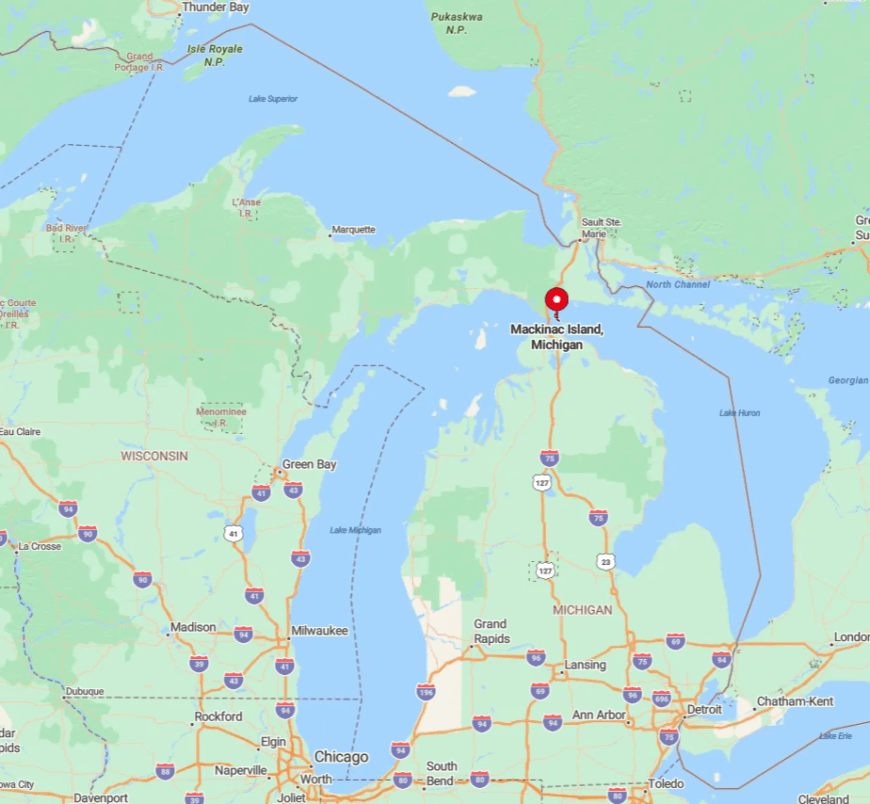
The island floats in the straits between Michigan’s Upper and Lower Peninsulas, reachable only by ferry from Mackinaw City or St. Ignace. Its limestone plateau rises above turquoise waters where Lakes Huron and Michigan converge, creating dramatic cliffside paths.
Pellston Regional Airport is the closest air link, 16 miles south of Mackinaw City, with shuttle buses connecting to the docks. Once on the island, visitors rely on foot, bicycle, or horse carriage, ensuring the Victorian atmosphere remains unbroken by engines.
2. Madison, Indiana: Antebellum Elegance Along the Ohio River
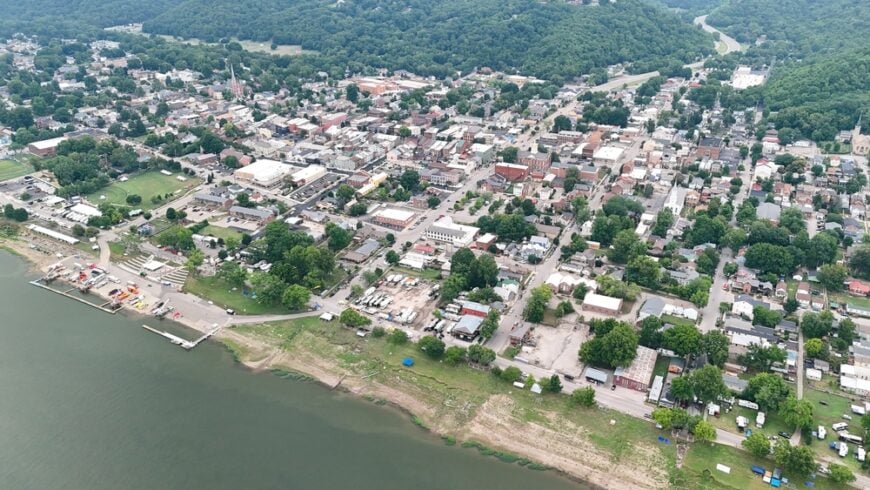
More than 130 blocks of Madison form the nation’s largest contiguous National Historic Landmark District, brimming with Greek Revival mansions and Federal row houses.
The showpiece Lanier Mansion dazzles with its spiral walnut staircase and riverfront gardens designed by landscape architect H. W. S. Cleveland. Nearby, the Jeremiah Sullivan House introduces visitors to 1820s frontier refinement, while the Dr. Hutchings Office displays early medical instruments.
Our group enjoys sipping locally roasted coffee on the porch of the Shrewsbury-Windle House, a stop along the Underground Railroad. Clifty Falls State Park borders the town, offering waterfall hikes that contrast neatly with brick-lined downtown strolls.
Nightlife features live bluegrass at the century-old Red Bicycle Hall, echoing between Italianate facades. Madison presents 3-4 bedroom homes priced between $250,000 and $550,000, a town known for its preserved historical homes and beautiful architecture.
Where is Madison?
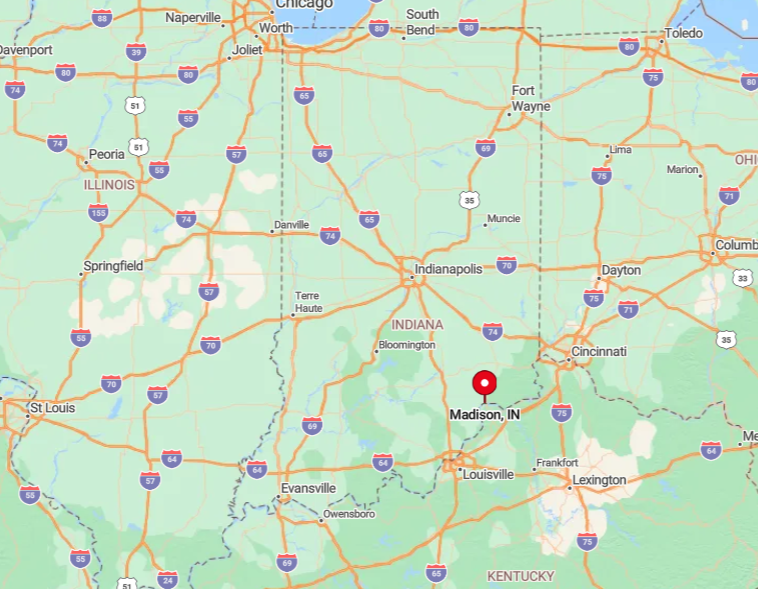
Madison lies about 50 miles northeast of Louisville via scenic Highway 62 on the north bank of the Ohio River in southern Indiana. Limestone bluffs ring the town, once enabling clifftop signal fires used by river pilots.
Louisville Muhammad Ali International Airport is the nearest major airport, and rental cars make the one-hour drive through rolling tobacco country. Many visitors arrive aboard riverboats docking at the public landing, maintaining the tradition of 19th-century steamboat tourism.
1. Galena, Illinois: 19th-Century Architecture Amid Rolling Hills
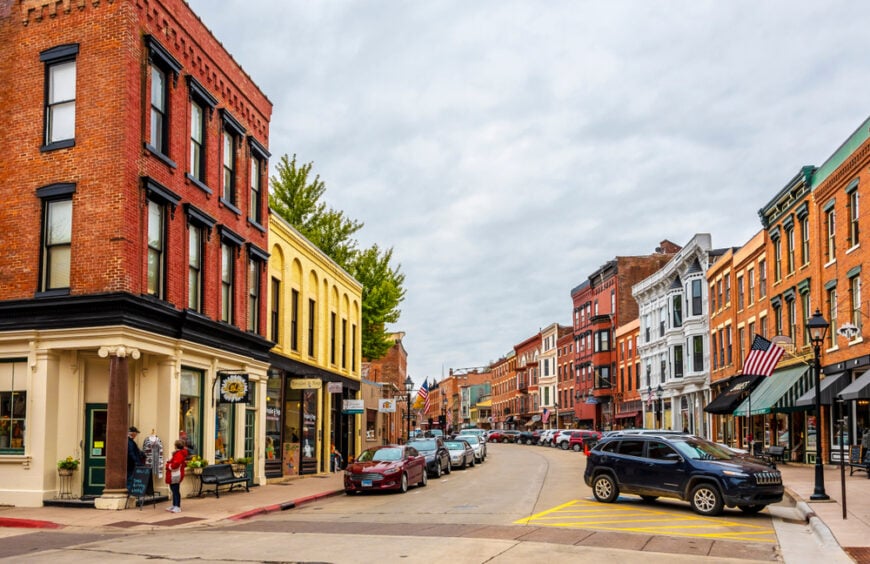
Galena’s hillside streets showcase more than 1,000 historic structures, brick façades, and cast-iron balconies testifying to an 1850s mining boom. The Dowling House, built in 1826, claims the title of oldest residence and still reveals primitive stone fireplaces from frontier days.
Visitors can tour the home of Ulysses S. Grant, gifted to him by grateful citizens after the Civil War, complete with original horsehair furnishings. Hidden two blocks off Main Street, the Belvedere Mansion dazzles with gold leaf mirrors and a chandelier rumored to have hung in “Gone with the Wind.”
Shoppers browse 19th-century storefronts for lead-white pottery and locally distilled apple brandy, while evening ghost walks share spine-tingling lore beside gas lamps. Hot-air balloons drifting over the Galena River valley at sunrise provide an unforgettable aerial view of the town’s serpentine streets and steep rooftops.
Galena offers 3-4 bedroom homes priced between $300,000 and $600,000, a charming town with well-preserved homes and a vibrant historical district to explore.
Where is Galena?
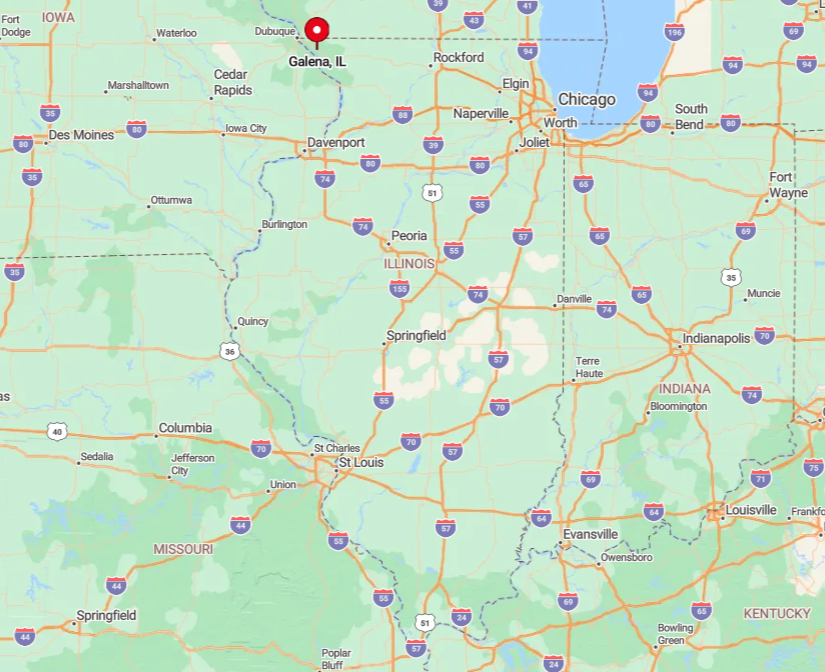
Galena perches in the northwest corner of Illinois, 16 miles east of the Mississippi River and 150 miles west of Chicago along U.S. Highway 20. The driftless topography escaped the flattening glaciers, resulting in scenic ridges and valleys ideal for panoramic drives.
Alternatively, visitors can fly into Dubuque Regional Airport, just 25 miles away, and hire a shuttle that winds through vineyards and dairy farms before descending into Galena’s historic core.


